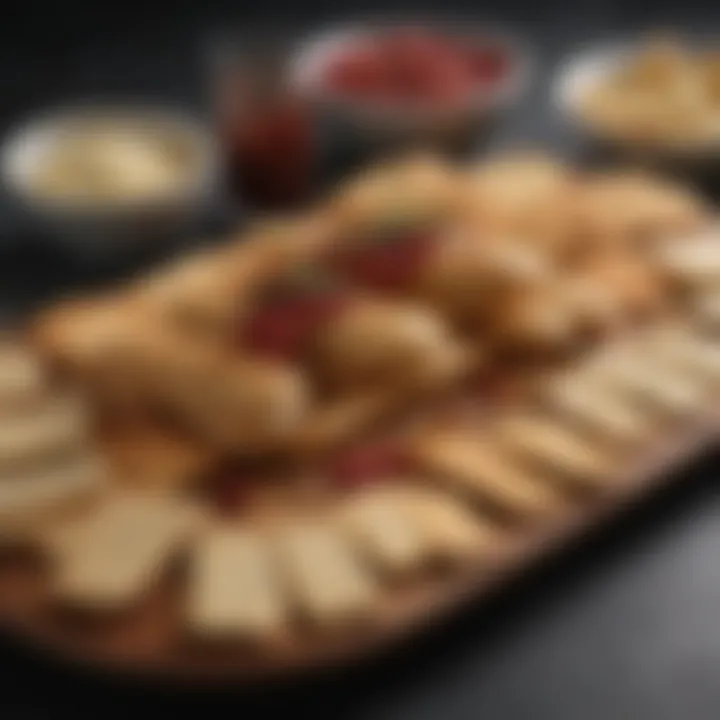Exploring Hot Crackers: A Culinary Delight Unveiled


Intro
Hot crackers sit at the intersection of simplicity and delight in the culinary landscape. Their rapidly growing popularity offers a grace and versatility that appeals to many. Historically, they have been used in many cuisines, serving as a foundation for numerous toppings, cheeses, and spreads. This article aims to unveil the many facets of hot crackers, guiding readers through preparation methods and variations.
Understanding the culinary significance is essential not only for food lovers but also for anyone seeking to expand their cooking repertoire. Busy cooks need uncomplicated and flavoursome solutions, especially in today's fast-paced world. The humble hot cracker rises to that challenge, transforming simple ingredients into crowd-pleasing snacks or even main dishes.
Thus, the following sections will explore recipes, technical guidance, customization options, time-saving techniques, and nutritional benefits. Let's take a closer look into this appealing culinary topic.
Recipe Highlight
Cheesy Chili Crackers
Where simplicity meets savoury goodness, cheesy chili crackers stand out. This enticing recipe combines the crunch of crackers with flavorful chili waves and a cheesy texture.
Essential Ingredients:
- 1 pack of plain water crackers
- 1 cup shredded cheddar cheese
- 1 can of chili (or homemade chili)
- 1 teaspoon paprika
- 1 tablespoon chili powder
- Fresh cilantro for garnish
Preparation Time: Approximately 15 minutes.
Servings: Around 4-6 serves.
Step-by-Step Instructions
- Preheat your oven to 375°F (190°C).
- On a baking sheet, lay out plain water crackers in a single layer.
- Spoon about one tablespoon of chili onto each cracker, making sure each one is sufficiently topped.
- Sprinkle shredded cheddar cheese over the chili generously.
- Season with paprika and chili powder, as per taste.
- Bake the crackers in the oven for about 7-10 minutes, or until cheese is melted and bubbling.
- Garnish with chopped cilantro before serving.
Cooking Tips:
Using frozen mixed chili can save time and ensure consistency. Be careful with measurements of paprika and chili powder, as the spice can overpower if overused. Common mistakes include overcrowding the baking sheet, which can lead to uneven cooking.
Variations and Substitutions
- Consider using different types of cheese, such as Monterey Jack or pepper jack, which can add unique flavors.
- For a lighter option, choose black bean chili or make a vegetarian alternative with mushrooms or lentils.
- Serve alongside fresh salsa or guacamole for added textures and tastes.
- Offer as a platter with assorted dips for variety.
Time-Saving Cooking Tips
- Chop cheese and garnish in advance to streamline the process.
- If high-efficiency is a goal, prepare multiple batches at once and freeze them uncooked.
- A pre-heated baking stone can drastically reduce cook-time and improve evenness.
Nutritional Information
These cheesy chili crackers yield about 150 calories per serving:
- Proteins: 7g
- Fibers: 3g
- Sugars: 1g
This dish accommodates gluten-free diets when utilizing certified gluten-free crackers. With alternatives suggested, almost everyone can find a way to enjoy this quick meal.
By understanding each aspect of hot crackers, you can add a delightful and efficient choice to your meal planning arsenal.
Intro to Hot Crackers
Hot crackers represent not just a quick snack, but a rich and layered category of food reflecting diverse cultures and gastronomic histories. This article takes a closer look at hot crackers, revealing the complexity and simplicity they embody. The topic proves to be relevant for both casual snackers and those passionate about culinary explorations.
By examining the uniqueness of hot crackers, we unveil how they serve as a canvas for various flavors and textures. In an age where convenience is vital, understanding the benefits of hot crackers can drive individuals towards flavor-packed yet uncomplicated cooking solutions. The fresh perspective provided here encourages readers to view hot crackers not merely as sides but as integral parts of their culinary journey.
Defining Hot Crackers
Hot crackers are baked or fried snacks that offer crunchiness and warmth, often infused with spices. These crackers usually come seasoned, making them a popular party food or a delightful addition to meals. They differ from standard crackers by incorporating bold flavors that elevate their taste profiles. Various ingredients contribute to the heat level, creating a diverse spectrum ranging from mildly spicy to intensely fiery. The simplicity in production juxtaposed with intricate flavoring techniques leads to interpretations across various kitchen scenes. This versatile food item allows culinary creativity and customization, making them appealing to many.
Historical Context
The evolution of hot crackers can be traced back to traditions spanning continents. Rooted primarily in inspiration from Asia, these crackers have adaptations that occurred over time in many cultures. For instance, the Chinese rice crackers and Indian papad influencing flavor profiles encapsulate historic experimentation with simple ingredients. Public interest in these crackers grew through time, intertwining them with cultural evenings and festive celebrations. Their accessibility and ease of preparation allowed these crispy snacks to transition from street vendors' offerings to mainstream celebrations, thus carving a distinct identity in culinary history. Understanding this historical context helps highlight how hot crackers developed into a beloved snack though regional variations persist today.
Types of Hot Crackers
Understanding the various types of hot crackers is essential in appreciating their diversity and significance in culinary practices. Each type embodies unique flavors and textures, explorng tolerances and preferences among societies and cultures. Some varieties are deeply rooted in tradition, while others emerge from modern experimentation with ingredients and techniques. The examination of these types can demonstrate their role in meals, parties, and casual snacking.
Traditional Hot Crackers
Traditional hot crackers are often loved for their comforting taste and nostalgia. They typically showcase regional ingredients and methods passed down through generations. Varieties, such as Cheddar Cheese Crackers or Spicy Pepper Crackers, invoke familiarity, frequently served during family gatherings or holidays.


- Cheddar Cheese Crackers: Made using sharp cheddar, these crackers provide a rich flavor. They are often enjoyed in combination with soups or salads.
- Spicy Pepper Crackers: Infused with red pepper flakes, they offer a delightful kick for those who crave heat. Serve these with cream cheese or dips for balanced taste.
Traditional hot crackers highlight food's emotional aspects—the harmony of taste and shared experience. This adds comfort to the dining table, making them popular choices for various events.
Modern Innovations
Modern innovations in hot crackers reflect the creativity of contemporary cooks and chefs who seek ways to redefine snack options. Encouraging quick preparation without neglecting taste in several speedy meals, innovative alternatives tailor to evolving dietary preferences.
Innovators utilize various grains, seeds, and even legumes to devise distinct pallets:
- Chickpea Crackers: Packed with protein, they cater to both health-conscious tasters and gluten-free dieters.
- Quinoa Seed Crackers: Emphasizing crunchy texture, they're excellent for dipping and appealing to a health-focused audience.
These innovations not only enhance the culinary landscape but also play a role in addressing specific dietary needs, making hot crackers a versatile and inclusive snack option.
Cultural Variations
Cultural variations of hot crackers exemplify the regional flair shown in different global contexts. Each culture imparts distinctive ingredients and flavors based on local availability.
Consider these specific examples:
- India: Papadums, thin and crispy, seasoned with spices like cumin or black pepper, are a common cultural adaptation, utilized in meals or served as a side snack.
- Latin America:
Ingredients for Hot Crackers
The ingredients for hot crackers make a significant contribution to their overall taste, texture, and nutritional profile. The right combination can create a delightful snack that appeals to a range of palates. Understanding these ingredients helps cooks apply their culinary skills more effectively, ensuring that their hot crackers stand out.
Basic Components
At the core of every hot cracker are a few essential ingredients. Typically, flour serves as the base. All-purpose flour is widely used, but whole wheat or gluten-free alternatives can be a good choice too. Additionally, fat is crucial for texture. Butter or oil adds both richness and flakiness to the cracker.
Other basic components include water or milk, which bind the mixture together, and salt for flavor enhancement. The proportion of these ingredients matters. The balance defines whether the finish is crunchy or soft. Substituting these ingredients may also cater to various dietary needs, reflecting the versatility that hot crackers offer.
Spices and Flavors
Spices and flavors can elevate the experience of eating hot crackers. A range of spices, from garlic powder to cayenne pepper, can be incorporated into the dough or sprinkled on top before baking or frying. Each spice adds depth, thereby transforming a simple cracker into a remarkable taste sensation.
Using top-notch ingredients is essential when choosing components like cheese, herbs, or seeds. For example, incorporating Parmesan cheese into the dough earns complementary flavors and a slight umami note. Finally, experimenting with fresh herbs like rosemary or thyme introduces an aromatic charm to hot crackers. Such additions not only amplify flavor but may also enhance nutritional benefits.
Healthier Alternatives
For health-conscious individuals, creating hot crackers with healthier alternatives is definitely possible. Instead of traditional flour, using oat flour or almond flour provides nutritional boosts without sacrificing flavor. These options tend to parent lighter textures and contribute different nutrients compared to standard all-purpose flour.
When it comes to fat, alternatives like avocado or coconut oil can be effective without creating a greasy finish. Their unique compositions also bring their unique health benefits. Regarding spices and flavorings, aiming for minimally processed ingredients ensures overall lower sodium levels while retaining a rich taste.
Drawing a clearer understanding about ingredients will allow cooks of all levels to craft personalized hot crackers that satisfy different tastes and dietary demands. As we come to realize what goes into making hot crackers, a wealth of easy yet appealing possibilities become visible.
"Selecting the perfect ingredients is key to achieving the desired flavor, texture, and the overall enjoyment of hot crackers."
Incorporating these ingredient considerations allows for versatile recipe creation while still assoicating common preparations with gourmet experiences.
Preparation Methods
Preparation methods are essential when crafting hot crackers. They determine not only the final texture but also the flavor profile of the crackers. Two dominant techniques are baking and frying, each offering a unique style and sensory experience.
Baking Techniques
Baking is the most common method for preparing hot crackers. It allows for an even cook that perfectly balances texture and flavor. The dry heat from the oven envelops the dough, producing a slightly crisp exterior while keeping the inside airy. The benefit here is also a healthier version compared to frying.
To bake hot crackers, start by preheating the oven to the required temperature, often between 350°F and 400°F. Roll out your dough to an even thickness, which is crucial to ensure uniform baking. After cutting to desired shapes, consider using parchment paper on your baking sheets to prevent sticking. Baking typically takes about 10-15 minutes, but monitoring is essential to avoid charring.
Key Benefits of Baking:
- Lower Fat Content: No oil is needed for the actual cooking process.
- Easy Clean-Up: Less involved than frying, saving both time and energy.
- Consistency: Allows for a standard treat, ideal for pairing with dips and toppings.
Frying Options
Frying presents an alternative method for creating hot crackers that amplifies flavor and creates that unmistakable crunch. However, this method means adding oil, leading to a denser product that often appeals to those craving a more traditional experience. The aroma encapsulated during frying enhances the overall taste, providing a deeper flavor profile often sought after by enthusiasts.
To fry hot crackers successfully, heat the oil in a suitable fryer or a deep pan. After the oil reaches around 350°F, gently add your cracker pieces in small batches. Careful attention is needed to avoid overcrowding, which can lower the oil temperature and affect the cook.


Spiral Frying Steps:
- Heat a generous amount of oil.
- Ensure oil is properly heated before adding dough pieces.
- Fry until is golden brown, often around criteria of 2-4 minutes.
- Remove from oil and drain excess on paper towels.
Key Benefits of Frying:
- Extra Crunch: The specific heat environment of frying delivers a crunch that baking cannot replicate.
- Flavor Depth: The oil infusion can play a significant role in overall taste.
- Variety in Texture: Enables unique texture variations appealing to diverse palettes.
Serving Suggestions
After mastering your chosen method, focusing on how to present and serve hot crackers can transform your culinary output. They can act as a wholesome snack, a companion for beverages, or a feature in casual gatherings. When serving hot crackers, consider these effective approaches:
- Dipping Trio: Present a variety of dips that contrast flavors. Consider cheese-based dips, flavorful salsas, or fresh, veggie-stuffed mixtures.
- Accompaniment Plates: Serve alongside antipasti items. Salami, olives, and pickled veggies provide dimension to flavors on offer.
- Personalized Platters: Give guests the option to customize their flavors by offering an array of toppings like seeds, spices, or spreads.
Delivering your main snack with thoughtful touches maximizes enjoyment and invites engagement from your eaters.
Engaging with both baking and frying bets the sensory nature of hot crackers gives a versatile space for culinary experimentation. Choose the method that fits your craving on any specific dayout and adapt the crackers to the occasion through thoughtful serving. This flexibility expresses the cracker's unyielded potential as a remarkable component in any culinary setting.
Hot Crackers in Culinary Culture
Hot crackers hold a unique position in culinary culture, manifesting both pleasure and practicality in countless dining scenarios. Their versatility allows them to seamlessly accompany a variety of dishes, making them essential in any kitchen. From informal gatherings to intricate feasts, their presence cannot be overlooked.
In various regional cuisines, hot crackers are often adapted to local ingredients and preferences, in turn enriching culinary traditions. This adaptability speaks volumes about their enduring popularity. Beyond just a simple snack, they ignite flavor combinations and create memorable meal experiences.
Regional Popularity
The regional popularity of hot crackers varies greatly across the globe, reflecting agricultural practices, cultural preferences, and historical influences. In the southern United States, the traditional saltine cracker is often elevated with spicy toppings, drawing on local flavors and hot pepper varieties. In contrast, in regions like Korea, hot rice crackers take on distinct characteristics, often using unique seasoning blends that reflect traditional Korean dishes.
Moreover, in regions bordering the Mediterranean, ciuciulette serve as a valued national snack, offering a crispy texture with hints of herbs and spices. This wide adaptation reveals that hot crackers are not confined to any one tradition, but thrive in multiple contexts, symbolizing how food evolves with cultural influences.
Key Highlights of Regional Popularity:
- The Southern U.S.: Saltine crackers with spicy toppings enhance flavor.
- Korea: Hot rice crackers featuring local spices produce unique tastes.
- Mediterranean: Ciuciulette brings local herbs into the cracker realm.
A common thread across these regions is the inclination to layer hot crackers with toppings, making them more than just a standalone item. Here, food becomes a canvas for creativity and expression.
Hot Crackers in Celebrations
Hot crackers frequently make appearances in celebrations across cultures, bridging together relatives and friends during gatherings. Their adaptability allows for creative, thematic variations that suit specific events. This adaptability adds flair to social occasions, where food often serves as a focal point.
For example, during the Super Bowl, spicy hot crackers support favorite dips and are able to hold various toppings without breaking apart easily. Similarly, during holiday seasons, families may prepare unique holiday-themed cracker variations using a blend of spices that symbolize seasonal flavors.
Furthermore, other festivals worldwide showcase regional hot cracker recipes that advantages local produce, celebrated through community potlucks or food fairs.
Summarized Benefits of Hot Crackers in Celebrations:
- Versatility: Can accommodate a wide range of tastes and cuisines.
- Thematic Enhancement: Adaptable toppings reflect the essence of the event.
- Social Connector: Facilitates sharing and interaction among guests.
Hot crackers serve more than a purpose as a snack; they unite people and offer a reflective taste of cultures during festivities.
In summary, hot crackers represent more than mere delicacies. Their relevance and adaptability to various cultural feasts present they symbolize deeper connections folks maintain through shared meals and traditions.
Nutritional Aspects
Nutritional aspects play a critical role in evaluating any culinary item, including hot crackers. Understanding their value can help differentiate between varieties, enhancing the choices available for conscious eaters. Balancing flavor and nutrition is important for people wanting satisfying snacks that won't lead to health concerns.
Caloric Content
Hot crackers can vary greatly in their caloric content depending on ingredients. A standard serving of traditional hot crackers typically contains between 100 to 200 calories. This range can change based upon the base ingredients, like flour or cornmeal, and added spices or oils. Knowing caloric content is useful for those monitoring their dietary intake, whether for weight management or overall heath. Enjoyed in moderation, hot crackers can fit into a balanced diet.
Health Benefits
Including hot crackers in your diet can offer various health benefits, especially when made from whole grains and natural ingredients. They can provide energy due to carbohydrate content. When paired with healthy dips, such as hummus or guacamole, you can effectively boost nutrient intake. Whole grain varieties typically include more fiber, which aids digestion. Moreover, the use of spices, which are often present in hot crackers, can enhance metabolism and offer antioxidant properties.
Potential Downsides
While hot crackers can be enjoyable, several potential downsides must be recognized. For one, many commercially-made options might contain excessive sodium or added sugars. High sodium intake is linked to hypertension and cardiovascular issues. Additionally, some hot crackers are fried, which can elevate trans fats that might increase the risk of heart disease. Finally, individuals with gluten sensitivity should cautiously explore this food because wheat-based hot crackers can trigger adverse reactions.
It's essential to scrutinize ingredient lists carefully to maintain a healthy diet when indulging in hot crackers. Nutrition is just one part of enjoying food; however, it significantly affects overall well-being.


Pairing Hot Crackers with Dips
Pairing hot crackers with dips is key to maximizing their flavor and texture. When these two elements come together, they create a memorable eating experience, where one complements the other. Dips add moisture and rich flavors that contrast beautifully with the crunchiness of crackers. Understanding various dip options can enhance your culinary exploration.
Cheese and Dairy Options
Cheese dips are classic choices for hot crackers. Whether it is a creamy five-cheese blend or a sharp cheddar dip, they provide rich and decadent flavors. Dairy options stand out due to their versatility and ease of preparation. For example, a traditional queso dip, which combines melted cheese and jalapeños, perfectly balances the subtle heat of the cracker.
In addition, dips like feta and yogurt blends incorporate tangy notes that harmonize well with spicy or savory crackers. Here are some popular cheese and dairy dip ideas:
- Creamy Spinach Artichoke Dip: A velvety blend of cream, spinach, and artichokes serves as both rich and refreshing.
- Buffalo Chicken Dip: Combines shredded chicken, cream cheese, and spicy sauce, catering to those craving heat and richness.
- Blue Cheese Dip: Is robust and aromatic, enhancing a simple cracker with bold character.
Vegetable-Based Dips
Vegetable-based dips offer a lighter and fresher alternative. Hummus is especially popular, since it pairs well with various cracker types. The creamy texture of hummus, along with flavors ranging from classic garlic to spicy harissa, complements the crunch bite of hot crackers nicely. Another good option is the tzatziki, a Greek dip made from yogurt, cucumber, and garlic. Its freshness provides a counterpoint to hotter dips and the crackers showcase its ingredients well.
Here are some noteworthy vegetable dip choices:
- Roasted Red Pepper Hummus: Adds depth with roasted sweetness and a subtle smokiness.
- Guacamole: A creamy combination of avocado, lime stones, and spices that viciously cuts through the spicy note of many crackers.
- Baba Ganoush: Transforms roasted eggplant into a savory dip with a smoky profile fitting for crackers.
Salsa and Spicy Accompaniments
Salsa offers versatile choices that can elevate hot crackers' appeal. From classic tomato-based salsa to mango or corn salsa, there are numerous flavor profiles to explore. The spices and acidity present in many salsa varieties can transform mild crackers into distinctly flavorful snacks. Furthermore, salsa can introduce an element of freshness when combined with heavier dipping options.
Here are essential types of salsa that pair well:
- Fresh Tomato Salsa: Provides vibrant acidity that refreshes the palate.
- Mango Salsa: Combines tart and sweet flavors, perfect for contrasting with a spice-coated cracker.
- Chipotle Salsa: Affords great depth and a smoked note, well suited to more robust flavored crackers.
Given the broad array of dip choices, pairing hot crackers with recommended dips can significantly enhance taste profiles, creating a dynamic culinary experience.
Innovative Hot Cracker Recipes
Innovative hot cracker recipes represent a key element in redefining how we perceive and prepare this popular snack. While hot crackers have motif of versatility, innovative approaches elevate them to a level of engagement that both novice and experienced cooks will find appealing. Implementing unique flavors, ingredients, and cooking techniques can transform an everyday snack into a gourmet experience. The use of creativity in crafting hot cracker recipes demonstrates not only culinary skills but also a desire to explore and enjoy flavorful offerings.
Gourmet Flavors
In the quest for enhancing the flavor profile of hot crackers, gourmet inspirations take center stage. Gourmet hot crackers doern't just satisfy basic cravings; they cultivate an experience rich in aromatic herbs, exotic spices, and unique fillers. Integrating ingredients like truffle oil, aged cheeses, or even artisan salts augments complexity and elevates the traditional cracker to new heights.
Considerations for creating gourmet flavors should focus on balance and complement. How do various ingredients come together? For example, hot crackers topped with goat cheese, crushed red pepper, and honey exemplify a perfect symbiosis of tangy and spicy with a touch of sweetness. Alternatively, herb-infused oils can provide an aromatic depth that enriches the tasting experience.
An ordered list of potential gourmet combinations is:
- Rosemary and Parmesan
- Chili Flakes and Lime Zest
- Pesto and Sun-Dried Tomatoes
- Blue Cheese and Fig Jam
- Smoked Paprika and Sour Cream
By testing different pairs and methods of cooking, chefs can create signature recipes that are unmistakenly unique. Exploring these flavor nuances offers more rich experience that also impresses deserving guests during dinner parties.
Vegan and Gluten-Free Options
The growing trend towards health-conscious eating has spurred demand for vegan and gluten-free versions of traditional snacks. For hot crackers, ensuring these options are satisfying requires both clever ingredient substitutions and attention to flavor.
Using gluten-free flours like almond or chickpea flour often provides not only texture but also added nutritional benefits. Toppers like avocado spread or hummus often complement the foundation offered by vegan crackers. Additionally, incorporating nutritional yeast can impart a cheese-like umami flavor, directly addressing common concerns of flavor sufficiency.
Important concepts in building these recipes include:
- Ingredient Selections: Always evaluate what best contributes taste.
- Texture: Maintaining crunchiness is key to enjoyable eating experiences.
- Diverse Flavor: Offer myriad tag lines to accentuate the cracker's character.
Gourmet vegan and gluten-free crackers do endure moments of challenge but lead ultimately to fun experimenting their flavors. An inspired home cook may enjoy concocting flavors listed such benfits as_LOW cholesrtylolsitian nand high essential nusencals. Create improvisational recipes that amazes all shared nutrients ornourishment.
“Innovative recipes blend tradition and novelty; the result is satisfaction for the discerning palate.”
Finale
The concluding section of this article emphasizes the versatile and evolving nature of hot crackers within culinary arts. As products of both tradition and innovation, hot crackers hold a significant place in the hearts and kitchens of many food enthusiasts. This multitude of forms and flavors underscores their adaptability, appealing even to modern tastes and dietary necessities. Understanding these facets of hot crackers aids both casual and serious cooks alike in broadening their culinary horizons.
The Future of Hot Crackers
Looking ahead, the future of hot crackers seems promising. There is a growing trend toward health-conscious eating, inspiring companies and home cooks to explore fresh ingredients and more wholesome recipes. Ideas such as using whole-grain flour or incorporating superfoods are becoming popular. Structure and texture could also receive attention, with potentially beneficial alterations in traditional recipes. This likely will lead to distinctions within global varieties of hot crackers. We may also anticipate advancements in preservation techniques, allowing for increased flavor retention in pre-packaged goods.
It's crucial for cooks and food creators to adapt. As palates evolve, so too must the characteristics of hot crackers. There’s potential for exciting new pairings with trendy foods and flavors from various cultural influences.
Encouragement for Home Cooks
Home cooks are urged to experiment with hot crackers. Encouragement comes from their simple nature, allowing freedom and creativity in the kitchen. Whether it's following established recipes or venturing into custom creations, there are countless paths to flavor discovery. Ingredients like diverse spices, unique oils, or even medicinal herbs can transform a basic recipe into something exceptional.
"The culinary landscape is always evolving, and the humble hot cracker is no exception, offering limitless possibilities."







